 Global| Jun 28 2006
Global| Jun 28 2006Mortgage Applications Fell Hard, Rates Above 7%
by:Tom Moeller
|in:Economy in Brief
Summary
The total number of mortgage applications fell a sharp 6.7% last week after a slight decline the prior week. The drop pulled the average number of applications 1.8% in June below the May average and applications were 32.0% below the [...]
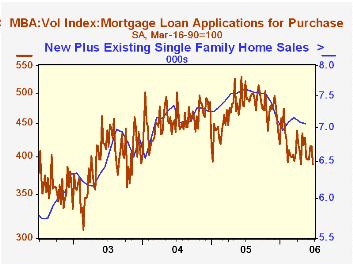
The total number of mortgage applications fell a sharp 6.7% last week after a slight decline the prior week. The drop pulled the average number of applications 1.8% in June below the May average and applications were 32.0% below the year ago level.
Applications to refinance cratered 7.5% last week, the fourth w/w drop this month. Refis in June were 3.2% below the May average and 46.4% below the year earlier level.
Purchase applications also fell sharply from the previous week. The 6.2% drop lowered the June average 1.3% below May and 18.5% below the year ago level.
During the last ten years there has been a 58% correlation between the y/y change in purchase applications and the change in new plus existing single family home sales.
The effective interest rate on a conventional 30-year mortgage rose another twelve basis points to 7.08%, the highest level since April 2002. The rate on 15-year financing also surged ten basis points to 6.75%. Interest rates on 15 and 30 year mortgages are closely correlated (>90%) with the rate on 10 year Treasury securities. 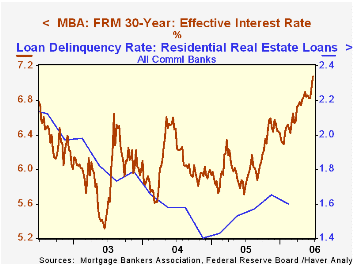
During the last ten years there has been a (negative) 79% correlation between the level of applications for purchase and the effective interest rate on a 30-year mortgage.
The Mortgage Bankers Association surveys between 20 to 35 of the top lenders in the U.S. housing industry to derive its refinance, purchase and market indexes. The weekly survey accounts for more than 40% of all applications processed each week by mortgage lenders. Visit the Mortgage Bankers Association site here.
The Price of Residential Land in Large U.S. Citiesfrom the Federal Reserve Board is available here.
| MBA Mortgage Applications (3/16/90=100) | 06/23/06 | 06/16/06 | Y/Y | 2005 | 2004 | 2003 |
|---|---|---|---|---|---|---|
| Total Market Index | 529.6 | 567.6 | -32.0% | 708.6 | 735.1 | 1,067.9 |
| Purchase | 389.0 | 414.8 | -18.5% | 470.9 | 454.5 | 395.1 |
| Refinancing | 1,356.0 | 1,466.1 | -46.4% | 2,092.3 | 2,366.8 | 4,981.8 |
by Carol Stone June 28, 2006
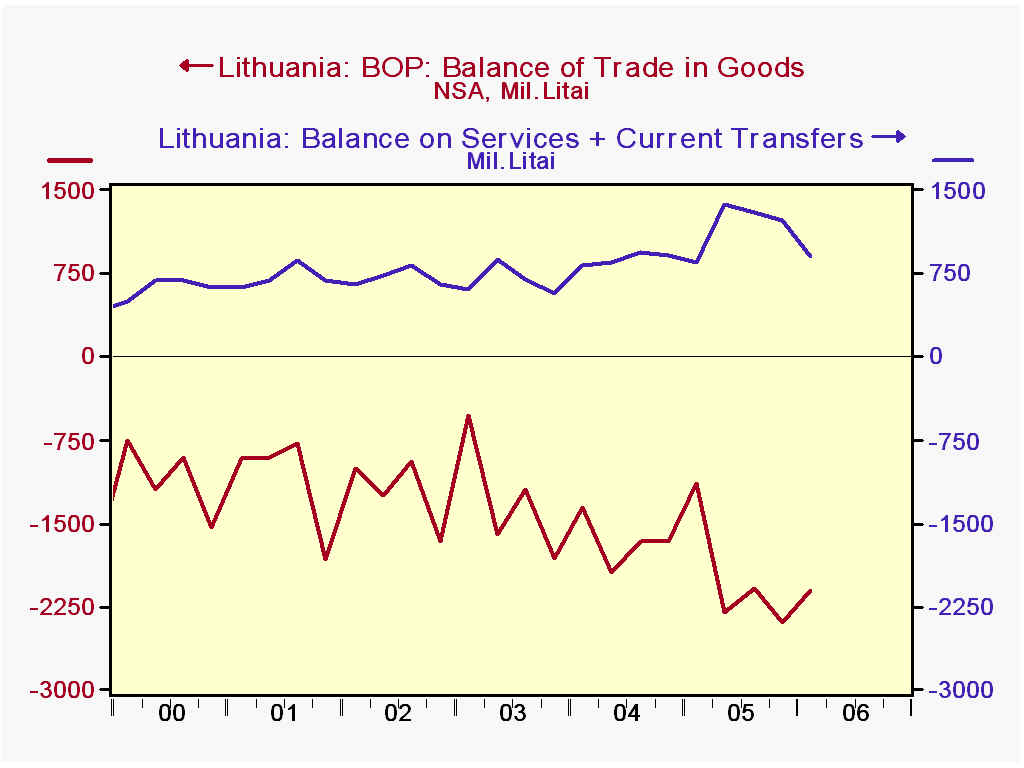
Balance of payments reports for two emerging European economies show a mixed picture for Q1 2006. In Lithuania, the current account has widened markedly over the last year, in rough parallel with gaping trade accounts. By contrast, Bosnia and Herzegovina are seeing a steadier trend in both current account and trade balances, although these not-seasonally adjusted figures are fairly erratic from quarter to quarter.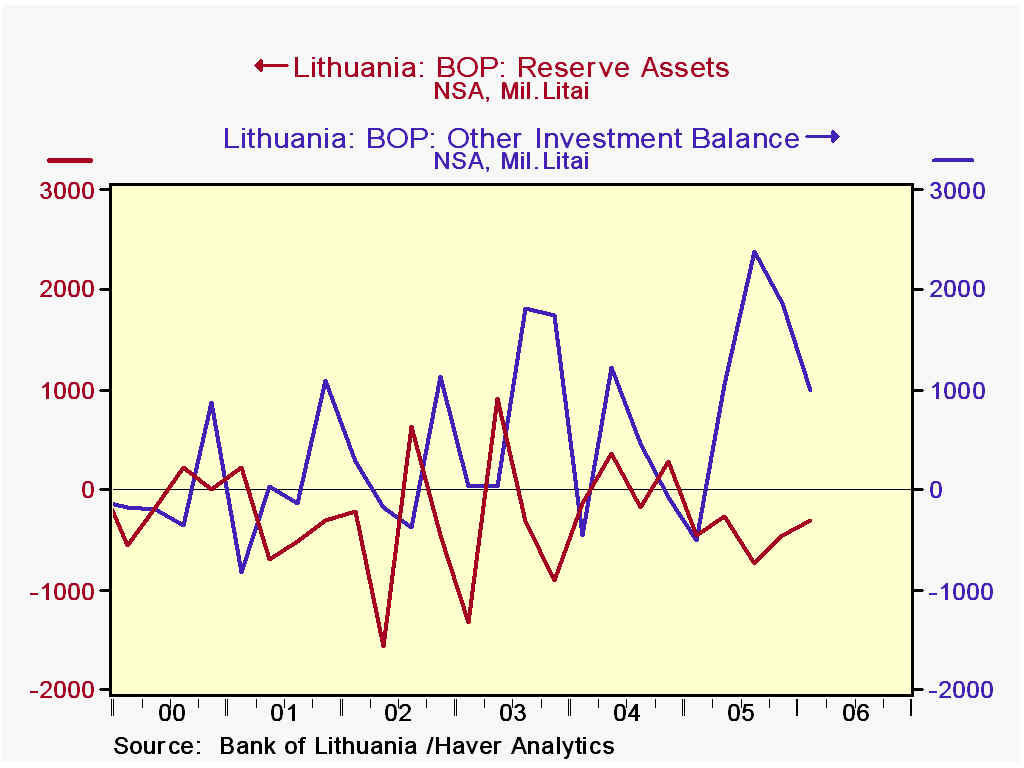
In Lithuania, imports surged in the spring of last year and continued rising through the summer. Until 2003, the usual seasonal pattern saw them ease in the summer quarter after their spring bounce. We presume the latest move is energy related. Fortunately, exports have been stronger in the last year than has been typical, but still not so vigorous as imports. Also fortunate have been larger surpluses on services and transfer receipts which have helped offset the larger trade deficit. On the financial accounts side of the balance of payments ledger, "other investment", generally bank loans, has increased and even Lithuania's capital account has shown a persistent and non-trivial surplus. However, some financing has also come from a decrease in foreign exchange reserves, not likely a comfortable position for the central bank.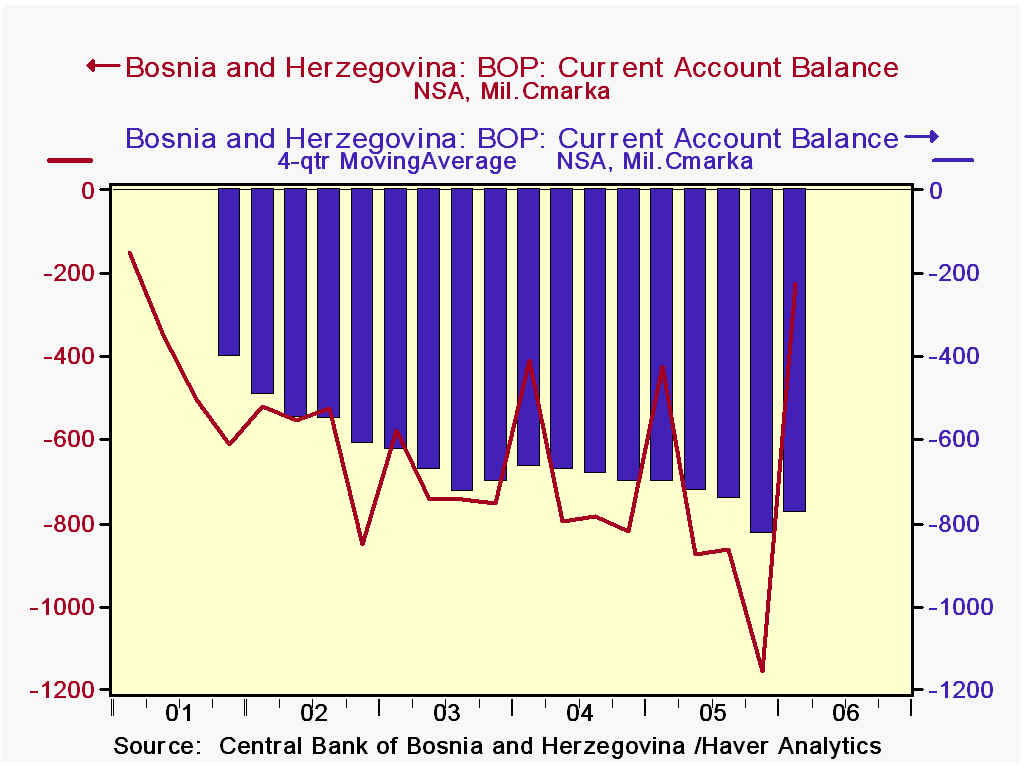
In Bosnia, the rise in imports has been much more temperate. Indeed, in Q1, imports were actually very slightly smaller than in Q1 2005. Combined with a firm uptrend in exports, the goods balance has deteriorated only modestly, rather than losing major ground as in some other countries. Financing for the goods deficit has come from a sustained inflow of current transfers (see graph) and from inflows of direct investment and "other" investment. Interestingly, Bosnia & Herzegovina has virtually no portfolio investment. There has been a moderate run-off of foreign exchange reserves.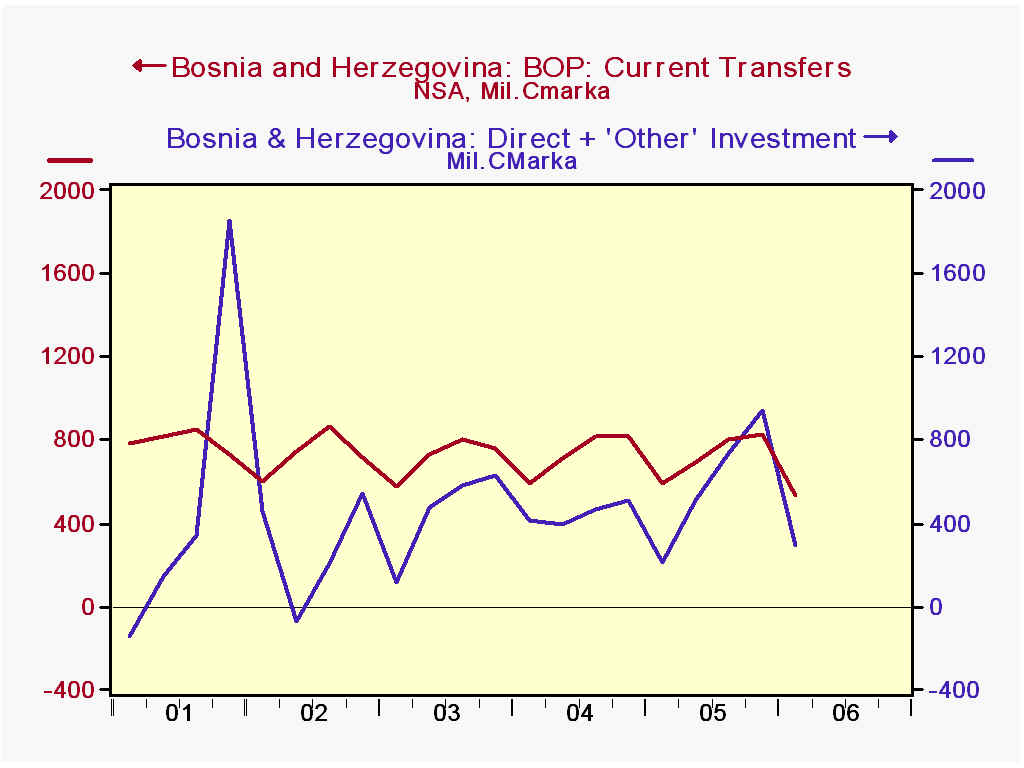
Both of these countries peg their currencies to the euro. Lithuania is a member of the EU-25, the segment added in 2004 that retain their own local currency, here the litas, which is 3.4528 to the euro. Bosnia has linked its currency, the Convertible Marka, to the euro since the inception of the euro in 1999. Monthly data for it are maintained by the Central Bank of Bosnia & Herzegovina from 2002. All of these data are contained in Haver's EMERGECW database and some data for Lithuania are also in EUROSTAT.
| Q1 2006 | Q4 2005 | Q1 2005 | Quarterly Averages||||
|---|---|---|---|---|---|---|
| 2005 | 2004 | 2003 | ||||
| Lithuania: Mil Litai, SA | ||||||
| Current Account | -2035.7 | -1308.4 | -1013.1 | -1234.5 | -1202.5 | -963.9 |
| Trade Balance | -2529.1 | -2202.6 | -1569.0 | -1982.0 | -1657.7 | -1285.2 |
| Financial Account Balance | 1650.5 | 907.9 | 340.1 | 931.4 | 878.1 | 789.6 |
| Bosnia: Mil. Convertible Marka, NSA | ||||||
| Current Account | -221.5 | -1154.4 | -424.3 | -829.0 | -702.5 | -705.9 |
| Trade Balance | -1089.4 | -2387.2 | -1400.1 | -1958.3 | -1798.2 | -1795.0 |
| Financial Account Balance | 44.8 | 688.8 | 234.1 | 412.8 | 276.1 | 371.5 |
Tom Moeller
AuthorMore in Author Profile »Prior to joining Haver Analytics in 2000, Mr. Moeller worked as the Economist at Chancellor Capital Management from 1985 to 1999. There, he developed comprehensive economic forecasts and interpreted economic data for equity and fixed income portfolio managers. Also at Chancellor, Mr. Moeller worked as an equity analyst and was responsible for researching and rating companies in the economically sensitive automobile and housing industries for investment in Chancellor’s equity portfolio. Prior to joining Chancellor, Mr. Moeller was an Economist at Citibank from 1979 to 1984. He also analyzed pricing behavior in the metals industry for the Council on Wage and Price Stability in Washington, D.C. In 1999, Mr. Moeller received the award for most accurate forecast from the Forecasters' Club of New York. From 1990 to 1992 he was President of the New York Association for Business Economists. Mr. Moeller earned an M.B.A. in Finance from Fordham University, where he graduated in 1987. He holds a Bachelor of Arts in Economics from George Washington University.






